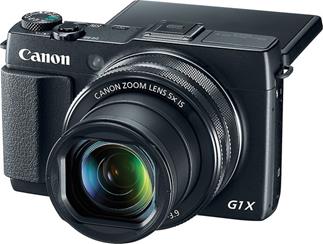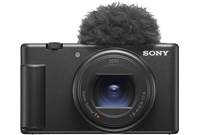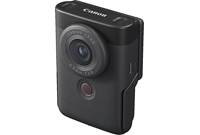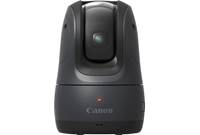About the Canon PowerShot G1X Mark II

High performance, low profile

The Canon PowerShot G1X Mark II features manual focus rings on the lens and a tilting LCD touchscreen.
High performance, low profile
Sure, the Canon PowerShot G1X Mark II can fit into your pocket or purse, but don't let the camera's small size deceive you; there's plenty going on inside that slim chassis. Canon built the Mark II around the fast, powerful DIGIC 6 processor, which makes sure your images are sharp and colorful. The image sensor that "sees" the image in the first place is almost as large as the one used in many of Canon's EOS SLR cameras, and sensitive enough so you can shoot vivid photos even in low light. The 3" LCD touchscreen tilts out for easier framing and viewing even when you're in the shot.
Focus on the fly
The Mark II is loaded with automatic modes that will help you get started, but it also features dual focus rings that allow you to make fine adjustments to the lens' focus when you want to take charge. With 12.8 megapixels and 5X optical zoom, even subjects a ways off can be captured in living color and pinpoint detail.
Wi-Fi® for sharing
The Mark II has built-in Wi-Fi® so you can upload images and videos to your smart device. That works both ways, so you can wirelessly fire the shutter on the camera when you're joining into a group shot — no need to set the timer and run when you have a wireless connection. If you're an Android™ user, the Mark II is equipped with Near Field Communication (NFC), so you can just touch a compatible phone or tablet to the camera and sync up instantly.
Product highlights:
- 12.8-megapixel effective recording
- large 1.5" high-sensitivity CMOS image sensor for top-notch image quality
- 3" variable-angle LCD touchscreen with 1.04 million-dot resolution
- optional hot-shoe mounted electronic viewfinder
- 5X optical zoom (4X digital)
- f/2.0-3.9 zoom lens
- optical image stabilization
- 35mm equivalent lens focal length: 24-120mm
- Wi-Fi® for instant wireless sharing of photos and video
- Near Field Communication (NFC) touch pairing with compatible Android devices
- dual control rings on lens allow DSLR-like manual focus control
- DIGIC 6 image processor delivers superior image quality and fast camera response
- highspeed burst mode (up to 5.2 frames per second continuous shooting)
- HDMI output for connection to an HDTV (requires mini HDMI cable, sold separately)
- records photos and video onto optional SD, SDHC and SDXC memory cards
Shooting Modes and Settings:
- face detection automatically sets focus, exposure, flash, and white balance for better portraits
- intelligent contrast correction brightens dark areas in your image while leaving properly exposed areas unchanged
- star shooting mode helps capture stunning images of the night sky
- high-definition movie mode (up to 1080p resolution)
- variable ISO (film speed equivalent) settings, including a high sensitivity setting for better low-light shooting
- exposure compensation settings
- custom white balance settings
- manual, aperture-priority, and shutter-priority exposure modes
Dimensions:
- 4-7/8"W x 2-15/16"H x 2-5/8"D
- weight: 19.5 oz. (with battery and media)
- warranty: 1 year
Supplied Accessories:
- rechargeable lithium ion battery (NB-12L)
- battery charger (CB-2LG)
- neck strap
- MFR # 9167b001
What's in the box:
Canon PowerShot G1X Mark II owner's manual
- Digital camera (black)
- NB-12L Lithium-Ion rechargeable battery (3.6V 1910mAh 6.8Wh)
- CB-2LG Battery charger
- Neck strap
- Getting Started booklet
- Warranty card
- Online registration card
- Wireless printing promo card
- Important Safety Instructions (for battery charger)
Customer reviews for Canon PowerShot G1X Mark II
Loading...
Loading reviews...
Average review:
4.5 out of 5 starsThanks for submitting your review
Customer photos
This review was collected as part of a promotion
Pros:
Cons:
More details on the Canon PowerShot G1X Mark II

Features & specs
| General | ||
|---|---|---|
| LCD Screen Size | 3" | |
| Adjustable-angle LCD | Yes | |
| Wi-Fi | Built-in | |
| Touchscreen | Yes | |
| Waterproof | No | |
| GPS-enabled | Smartphone | |
| Lens 35mm Equivalent | 24-120mm | |
| Optical Zoom | 4x | |
| Digital Zoom | 5x | |
| Filter Diameter | N/A | |
| Manual Focusing | Yes | |
| Manual Exposure | Yes | |
| Built-in Flash | Yes | |
| HDMI Output | Micro | |
| Memory | ||
| Internal Memory | None | |
| Memory Stick | No | |
| CFexpress Cards | No | |
| CompactFlash Cards | No | |
| SD Cards | SD, SDHC, SDXC | |
| XQD Cards | No | |
| Image | ||
| Sensor Size | 1.5" | |
| Megapixels | 12.8 | |
| Image Stabilization | Optical | |
| Highest Resolution | 4352 x 2904 | |
| 4K Video | No | |
| Video Resolution | 1920 x 1080/30p | |
| Dimensions | ||
| Width (inches) | 4-7/8 | |
| Height (inches) | 2-15/16 | |
| Depth (inches) | 2-5/8 | |
| Weight With Battery (ounces) | 19.51 | |
| Warranty | ||
| Parts Warranty | 1 Year | |
| Labor Warranty | 1 Year | |
Product Research
Features
Play, Edit, and Print Functions
Battery Information
Input and Output Notes
Software
Features
Vari-Angle LCD Monitor: The Canon PowerShot G1 X Mark II has a 3" TFT color vari-angle capacitive touch panel LCD monitor featuring a resolution of approximately 922,000 dots. The monitor has an approximately 100% picture coverage. The touch-sensitive panel gives you easy access to operations, menus, and controls. Using Touch AF, you can set the focus point and activate the shutter release with the touch of a fingertip. Like modern smart devices, you can also utilize the swipe and pinch actions on the LCD panel for other functions. The vari-angle LCD monitor can be tilted up 180° or down 45° so you can take pictures at nearly every angle. You can manually adjust the LCD monitor's brightness.
Optional EVF: The optional EFV-DC1 Electronic Viewfinder offers a high-resolution view and displays all shooting information. The EFV-DC1 mounts to the accessory shoe, and can tilt up to 90° to let you shoot at different angles. It has a dioptric adjustment to let you focus the high-resolution LCD to your eyesight, with or without eyeglasses.
Canon's HS System: The PowerShot G1 X MkII employs the HS System by combining the 1.5", 12.8 Megapixel CMOS Image Sensor with the new DIGIC 6 Image Processor to produce spectacular images with minimal noise:
- Image Sensor: For optimal image quality, the camera uses a 1.5" CMOS image sensor with approximately 15-million total pixels and 12.8-million effective pixels for 3:2 and 13.1-million for 4:3, giving your shots added depth and detail. At 1.5 inches, the sensor is approximately 4.5 times larger than that of the PowerShot G16, and just slightly smaller than the APS-C size sensor used in Canon EOS DSLR cameras. It has a native 3:2 aspect ratio, just like EOS cameras.
- Image Processor: The G1 X MkII features Canon's latest generation DIGIC 6 Image Processor. The new processor offers improved light sensitivity for higher resolution with less noise when shooting in dark conditions. It also allows high speed continuous still image recording at full resolution.
Built-in Wi-Fi: The camera's built-in Wi-Fi lets you wirelessly connect to and send images to computers or smartphones, upload images to social networking sites, photo and video-sharing websites, or use in emails, using the Canon iMage Gateway application. You can also send images to other cameras or wireless printers. With the CameraWindow app, you can use Near-Field Communications (NFC) to easily pair the camera with your NFC-compatible Android phone (using OS 4.0 or later) by touching the two devices together at the camera's "N-mark." You can also shoot images remotely via your smartphone.
Geotagging: GPS data recorded on a smartphone using the CameraWindow app can be added to images taken by the G1 X MkII. Location information, such as latitude, longitude, and elevation, can be used to identify the precise location where your photos are taken, and display the photos on a map.
Recording Media: The camera records still images or moving images with stereo audio on SD, SDHC, and SDXC Memory Cards, including support for high-speed UHS-I memory cards.
File Formats: The G1 X MkII records still images and movies in the following file formats:
- JPEG: JPEG images are processed inside the camera for optimum image quality and compressed. There are two compression ratios to choose from: Super Fine and Fine. You can record JPEG images in Large, Medium 1, Medium 2, and Small in 16:9, 3:2, 4:3, 1:1, and 4:5 aspect ratios.
- RAW: The RAW file format records the image data as captured by the camera imaging element without further processing. The images show almost no deterioration in image quality, and are a higher quality than JPEG images. To view RAW images on your computer, you must use the Digital Photo Professional software (downloadable from the Canon website). Using the software's image processing function, you can broadly adjust the images without deterioration, and then convert the image to a JPEG, TIFF, or other type of image in line with your intended use. You can choose to record RAW files or JPEG files alone, or you can record RAW files and JPEG files simultaneously. RAW images can be recorded in any aspect ratio.
- Movies: Using the dedicated Movie button, you can record movies in High Definition or Standard Definition with stereo sound in MP4 format: Image Data: MPEG-4 AVC/H.264; Audio Data: MPEG-4 AAC-LC. HD Movies are recorded at 1920 x 1080 at 30 frames per second and 1280 x 720 at 30 fps. SD Movies are recorded at 640 x 480 at 30 fps. In addition, the camera can record iFrame movies, Miniature Effect movies, and Star Time-Lapse movies to show movement of objects in the night sky.
Image Sizes: The camera can record in the following image sizes and aspect ratios for JPEG and RAW still images:
| Image Size | 16:9 | 3:2 | 4:3 | 1:1 | 4:5 |
|---|---|---|---|---|---|
| Large | 4352 x 2448 | 4352 x 2904 | 4160 x 3120 | 3120 x 3120 | 2496 x 3120 |
| Medium 1 | 3072 x 1728 | 3072 x 2048 | 3072 x 2304 | 2304 x 2304 | 1840 x 2304 |
| Medium 2 | 1920 x 1080 | 2048 x 1368 | 2048 x 1536 | 1536 x 1536 | 1232 x 1536 |
| Small | 640 x 360 | 640 x 424 | 640 x 480 | 480 x 480 | 384 x 480 |
Wide-Angle 5x Optical Zoom Lens: The PowerShot G1 X MkII is equipped with an f/2.0-f/3.9, 5x Optical Zoom lens with a focal length of 12.5-62.5mm (35mm film equivalent: 24-120mm. The 4x digital zoom extends the camera's telephoto capabilities to a total zoom of 20x. The lens has a 9-blade aperture to provide beautiful blurred backgrounds, even at full-range zoom. The focusing range differs depending upon the focusing mode:
- Normal/Auto: 2" - infinity (W), 1.3' - infinity (T)
- Macro/Underwater Macro: 2" - 1.6' (W)
- Quick: 4.9' - 66' (W, T)
Digital Tele-Converter: Using the built-in Digital Tele-Converter, you can increase the focal length of the lens by approximately 1.6x or 2.0x. The focal length when using the 1.6x digital tele-converter is 38.4-192mm. When using the 2.0x tele-converter, the focal length is 48-240mm. The Digital Tele-Converter cannot be used together with the digital zoom.
Preset Focal Lengths: You can shoot at preset focal lengths of 24mm, 28mm, 35mm, 50mm, 85mm, 100mm, or 112mm. This feature allows you to shoot at the angle of view of those focal lengths to replicate the use of various prime lenses at the same focal lengths.
Dual Control Rings: The camera features two control rings surrounding the lens barrel which are designed to enhance functionality. The inner "step" ring can be configured to set the aperture value, shutter speed, and exposure compensation. The outer "continuous" ring helps you make fine tuning adjustments, including manual focus.
Optical Image Stabilizer: Optical (lens shift type) Image Stabilization allows you to minimize the camera shake which results in blurred images when you shoot distant subjects that have been magnified or when you shoot in dark conditions. Intelligent Image Stabilization (Intelligent IS) automatically selects one of six modes of image stabilization depending upon the shooting conditions:
- Normal: Image stabilization for still images
- Panning: Image stabilization for still images, when you follow subjects horizontally or vertically with the camera
- Hybrid IS: Image stabilization for macro shots and macro movie recording
- Dynamic IS: Image stabilization for movies, reducing strong camera shake as when shooting while walking.
- Powered IS: Image stabilization for subtle camera shake, such as when shooting movies at telephoto.
- Tripod IS: No image stabilization, because the camera is mounted on a tripod, or held still by other means. However, during movie recording, this mode will counteract wind or other sources of vibration.
Star Shooting Modes: The G1 X MkII features new Star Shooting modes to help you take photographs of stars in the night sky. Each of these modes requires a tripod to prevent camera shake. Other functions, including Night Display, Color Adjustment, and Star Emphasis, help you make your nighttime photos better. The Star Shooting modes include:
- Star Portrait: This mode lets you capture photos of people against a starry sky. After initially firing the flash to capture the person, the camera shoots twice without the flash. The three images are combined into a single image, and processed to make the stars more prominent.
- Star Nightscape: Lets you capture impressive shots of starry skies above night scenes. The stars are automatically enhanced to make them more visible.
- Star Trails: Streaks created by the movement of stars through the sky. You can set a shutter speed and the number of shots, and the camera shoots continuously, over an extended period (around two hours).
- Star Time-Lapse Movie: Still images are captured continuously at a specified interval and over a certain, and combined to create a movie. During playback, you can view the movement of stars through the sky in a short time.
AF Frame Modes: You can change the AF frame mode to match the scene you want to shoot. You can choose from the following:
- Face AiAF: The camera automatically detects the position of a face and uses the data to set the focus, exposure, and white balance (auto).
- 1-point: One AF frame is displayed, which can be moved by touching the screen for reliable focusing. You can also change the size of the single AF frame, if needed.
AF-Assist Beam: The AF-assist beam will sometimes emit when the shutter button is pressed halfway to assist focusing in certain conditions, i.e. dark conditions. The AF-assist beam can be turned off. If animals are your subject, turn off the beam when shooting in the dark to avoid startling them.
Focus Lock: If it becomes difficult to focus on the subject due to low contrast to the surroundings, close up and far away subjects in the same shot, or quickly moving subjects, you can choose to lock the focus or auto focus on an object at a similar distance, then shoot the picture after recomposing the shot.
Focus Bracketing: The camera automatically takes three shots; one at the manual focus position, and one each with focus positions preset farther and nearer. The three shots are taken at the same interval as continuous shooting. The farther and nearer focus positions can be set in three steps.
Drive Modes: The Canon PowerShot G1 X MkII features Single, Continuous, Self-Timer Drive modes:
- Single Shot: The digital camera captures a single image each time the shutter button is fully pressed and released.
- Continuous Shooting Mode: You can use this mode to
shoot successive frames while the shutter button is fully pressed. There are
three modes:
- Continuous: records approximately 5.2 images per second, focus is fixed on the original subject distance
- Continuous AF (auto focus): records approximately 3 images per second, focus adjusts as needed
- Continuous LV (live view): records approximately 3.1 images per second, focus is fixed at a manual setting
- Self-Timer: The self-timer can be used to shoot a group photo that includes the photographer. The camera will activate approximately 10 seconds after a preset time after shutter button is pressed to allow the photographer time to get into the shot. A 2-second self timer is also available if you want to avoid camera shake. The camera features a custom self timer, allowing you to set the time delay (0-10, 15, 20, or 30 seconds) and the number of shots taken (1-10 shots). In addition, the camera features a Wink Self-Timer (shoots 2 seconds after a wink is detected), and a Face Self-Timer (shoots 2 seconds after the camera detects a new face in the frame, presumably when the photographer has entered the picture).
Shooting Modes: Using the Mode Dial on the top of the camera, you can select from numerous shooting modes:
- Smart Auto: Advanced Canon technology intelligently analyzes your situation and shooting conditions, and automatically selects an appropriate setting.
- Hybrid Auto: You can make a short movie of the day while shooting still images. The camera records 2-4 second clips of scenes just before each shot and combines them into a digest movie.
- Program AE (P): The camera automatically sets both the aperture and the shutter speed.
- Shutter Speed Priority (Tv): When you set the shutter speed, the camera sets the aperture according to shooting conditions. The shutter speed can be set between 1/4000 and 15 seconds.
- Aperture Priority (Av): When you set the aperture, the camera sets the shutter speed according to shooting conditions. The aperture can be set between f/2.0 and f/16 (wide angle) and f/3.9 and f/16 (telephoto), depending upon the zoom position.
- Manual (M): The aperture (f/2.0-16 (W) or f/3.9-16 (T)) and the shutter speed (1/4000 to 60 seconds) are manually set.
- Custom Modes (C1/C2): You can register commonly used shooting modes and settings to your preference. These can be stored under C1 or C2 on the Mode Dial.
- Movies: allows you to set the camera for standard or iFrame movies, and configure the settings. The camera has a dedicated movie button to start and stop movie recording.
- Creative Filters: You can add a variety of filter effects to images when shooting. Filters include Super Vivid, Poster Effect, High Dynamic Range, Nostalgic, Fish-eye Effect, Miniature Effect, Toy Camera Effect, Background Defocus, Soft Focus, and Monochrome.
- Scene Modes: Appropriate settings for specific scenes and shooting conditions: Portrait, Smart Shutter, Star, Handheld NightScene, Underwater (requires optional waterproof case), Snow, and Fireworks .
- Creative Shot: The camera determines the subject and shooting conditions, automatically applying special effects and recomposing the shot to emphasize the subject. Six still images are recorded for each shot, each with a different effect, including Auto, Retro, Monochrome, Special, and Natural.
Exposure Compensation: When shooting against a bright or dark background, you may need to correct the exposure so that the subject is correctly lit. You can adjust the exposure from -3 to +3 in 1/3-stop increments.
Locking the Exposure Setting (AE Lock): You can set the exposure and focus separately. This is effective when the contrast is too strong between the subject and background, or when a subject is backlit.
Auto Exposure Bracketing (AEB): In this mode, the camera automatically changes the exposure within a set range to take three shots at the same interval as continuous shooting. The images are shot in the following order: standard exposure, underexposure, and overexposure. You can set the amount of under- or over-exposure from -2 to +2 in 1/3-stop increments.
Metering Modes: You can select from the following metering modes:
- Evaluative: Used for standard conditions. The area within the frame is divided into several zones and light is measured based on subject position, brightness, direct light and backlighting.
- Center-Weighted Averaging: Averages the exposure from the entire image, but places more weight on the subject at the center.
- Spot: Meters the area within the spot AE point at the center of the LCD monitor.
ISO Settings: The PowerShot G1 X MkII features Auto and Manual ISO. The higher the ISO, the greater it reduces the effects of camera shake and sharpens subjects in low-light situations. ISO speed settings can be adjusted in 1/3 EV increments. The settings include 100, 125, 160, 200, 250, 320, 400, 500, 640, 800, 1000, 1250, 1600, 2000, 2500, 3200, 4000, 5000, 6400, 8000, 10000, 12800, or Auto.
Built-In Flash: The PowerShot G1 X MkII has a built-in flash. Using the control dial, you can select Auto (flash fires in low light), On (flash always fires), Slow-Synchro (flash timing is adjusted to slow shutter speeds) or Off (flash doesn't fire). The built-in flash has a range of 1.6' to 22' in Wide Angle and 4.6' to 11' in Telephoto. You can adjust the flash output (3 levels) and flash exposure compensation (+/-2 stops in 1/3 stop increments). In the menu, you can add the following flash functions when the flash is set to On or Auto:
- Red-Eye Correction: You can automatically correct red-eye that occurs in images taken with the flash.
- Red-Eye Reduction Lamp: The red-eye reduction lamp lights in order to reduce the red-eye effect that occurs when shooting in dark conditions with the flash.
ND Filter: The ND filter reduces light intensity to 1/8 (3-stops) of the actual level, allowing for slower shutter speeds and smaller aperture values. Use of a tripod is recommended with the slower shutter speeds to prevent camera shake.
White Balance: You can choose from the following white balance settings:
- Auto: The camera sets the white balance automatically according to shooting conditions.
- Daylight: For recording outdoors on a bright day.
- Shade: For shooting in the shade.
- Cloudy: For recording under overcast, shady or twilight skies.
- Tungsten: For recording under tungsten and bulb-type 3-wavelength fluorescent lighting.
- Fluorescent: For recording under warm-white, cool-white or warm-white (3-wavelength) fluorescent lighting.
- Fluorescent H: For recording under daylight fluorescent, or daylight fluorescent-type (3-wavelength) fluorescent lighting
- Flash: For when recording with the flash.
- Underwater: Underwater sets the optimum white balance for taking pictures underwater; reducing blue tones to produce natural, vibrant hues.
- Custom: Allows you to manually set the white balance and store the settings.
My Colors: Using My Colors you can easily change colors in an image when it's taken. My Colors offers several options:
- Vivid: emphasizes contrast and color saturation to record bold colors
- Neutral: tones down contrast and color saturation to record neutral hues
- Sepia: brownish tint
- B/W: black and white
- Positive Film: makes blue, green or red colors more intense
- Lighter Skin Tone: makes skin tones lighter
- Darker Skin Tone: makes skin tones darker
- Vivid Blue: emphasizes blue tint
- Vivid Green: emphasizes green tint
- Vivid Red: emphasizes red tint
- Custom Color: manually adjust the contrast, sharpness, and color saturation
- My Colors Off: records normally with this setting
Display Overlays: You can display a variety of guides and overlays in the viewfinder or LCD to aid you in shooting images. These include shooting information, grid lines, an electronic level, and a histogram.
Wind Filter: The Wind Filter suppresses noise during audio recording when the wind is strong.
Optional Flash Units: The camera's accessory shoe can accommodate a variety of Canon Speedlite flash units. Available flash units include the Speedlite 600EX, 430EXII, 320EX, 270EXII, and 90EX.
Play, Edit, and Print Functions
Review: After an image is recorded, it will appear in the LCD monitor for a preset number of seconds for reviewing. You can select the review time from Quick, 2 seconds, 4 seconds, 8 seconds, or Off. It will also display until you press the shutter button halfway to focus your next shot (Hold).
Focus Check Display: Focus Check display allows you to check the focus of image taken and allows you to easily check facial expressions and whether a subject's eyes are closed. This feature can be set to allow you to check the focus of an image taken right after shooting the subject.
Jump Images: When you have a lot of images recorded onto a memory card, you can use the Jump feature to speed up your search for the image you want to view. You can choose from the following categories:
- Favorites: displays images tagged as favorites
- Shot Date: displays the images shot on a specified date
- Still/Movie: jumps to only still images or only movies
- Jump 10 Images: jumps over 10 images at a time
- Jump 100 Images: jumps over 100 images at a time
Index Replay: This feature allows you to view 6, 12, 42, or 110 images at once on the LCD monitor so that you can search for an image quickly.
Image Magnification: When viewing a still picture in Single Image Replay mode, you can magnify the image to get a closer look at the detail. You can also maneuver around in the magnified picture by using the multi-purpose control dial.
Rotating Images: You can rotate an image by 90° or 270° clockwise in the LCD monitor.
Smart Shuffle: Based on the current image, the camera suggests four images that you may want to view. After you choose one of those images, four more images are offered, making it an enjoyable way to play back images in an unexpected order.
Slide Show: Images stored on a memory card can automatically be displayed one-by-one using the Slide Show function. Each image displays for approximately 3-10, 15, 30 seconds. You can choose whether you want a fade transition effect or not.
Movie Playback: In addition to normal playback of your video clips the camera features slow-motion, fast-forward, rewind and frame-by-frame playback.
Trimming: You can trim a portion of a recorded image and save it as a new image file. You can also trim the beginnings and ends of recorded movies in one-second increments.
Resizing Images: You can resize images to a lower pixel setting and save the resized image as a separate file.
Protecting Images: The protect feature allows you to protect important images from accidental erasure.
PictBridge/Wireless Printing: You can connect this camera directly to a PictBridge-compatible printer of any brand with an optional USB cable and print photos without having to connect it to a computer. You can also connect the camera wirelessly via an access point or directly.
Battery Information
Power Requirements: The Canon PowerShot G1 X MkII powered by the supplied NB-12L rechargeable Lithium-Ion battery pack (3.6V / 1910mAh / 6.8Wh). The battery pack can be charged in the supplied CB-2LG battery charger in approximately 3 hours and 5 minutes. For long periods of continuous use, or when connected to a computer, it is recommended that the camera be connected to the optional ACK-DC100 AC adapter kit. The typical performance of the battery is as follows:
| Still Images | Screen On: Approx 240 shots | ||
|---|---|---|---|
| Eco Mode: Approx. 300 shots | |||
| Movie Recording | Typical | Screen On: Approx. 50 mins | |
| Continuous | Screen On: Approx. 90 mins | ||
| Playback Time | Screen On: Approx. 5 hours | ||
Eco Mode: To save battery power, the screen darkens when the camera is not used for approximately two seconds, then turns off after another ten seconds. The camera shuts itself off after three minutes of inactivity.
Input and Output Notes
Digital/AV Output Terminal: The PowerShot G1 X MkII has a Mini-B USB 2.0 Hi-Speed terminal to allow you to connect the camera to a compatible computer or compatible printer via a USB cable (not included). The camera's Mini-B USB 2.0 output also allows you to connect the camera to a TV or video monitor with a RCA audio and composite video input jacks using the optional AVC-DC400ST stereo AV cable. You can set the video output to NTSC or PAL.
Micro HDMI Output: The PowerShot G1 X MkII features a micro-HDMI (Type D) output for connecting the camera to your HDTV.
Remote In: The PowerShot G1 X MkII features a 2.5mm sub-mini input for connecting the optional Canon RS-60E3 Wired Remote Switch (sold separately). The remote prevents camera shake when taking photographs using a tripod, such as when taking close-ups, long-exposure, or Star Shooting photographs.
DC In: The camera features a DC input for optional AC power adapter (ACK-DC100, sold separately).
Software
Software: The PowerShot G1 X MkII does not come with software in the box. The following software programs are available for download from the Canon website:
- CameraWindow: import images and change camera settings
- ImageBrowser EX: manage images, view, search, organize, print, and edit images
- Digital Photo Professional: browse, process, and edit RAW images
- Camera User Guide
Operating Systems: The software is compatible with the following operating systems:
- Windows: Compatible with Windows 8/8.1, Windows 7 (SP1), Windows Vista (SP2), and Windows XP (SP3)
- Macintosh: Compatible with OS X 10.9, 10.8, and 10.7
Loading...
Loading accessories...
Customer Q&A
Loading...
Loading articles...













It has taken me a while to familiarize myself with this camera due to the myriad options and features, but the more that I learn the more impressed I become. The low light capabilities are fantastic in general, and the Handheld Nightscene feature is truly amazing.
Mark from Arcata, CA